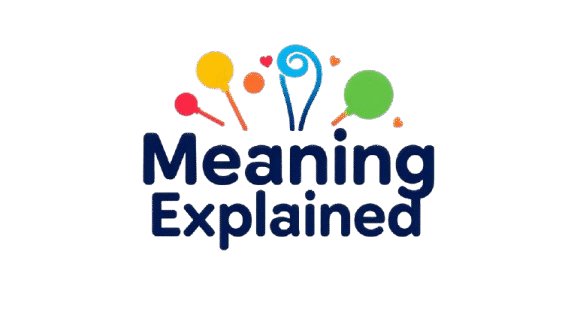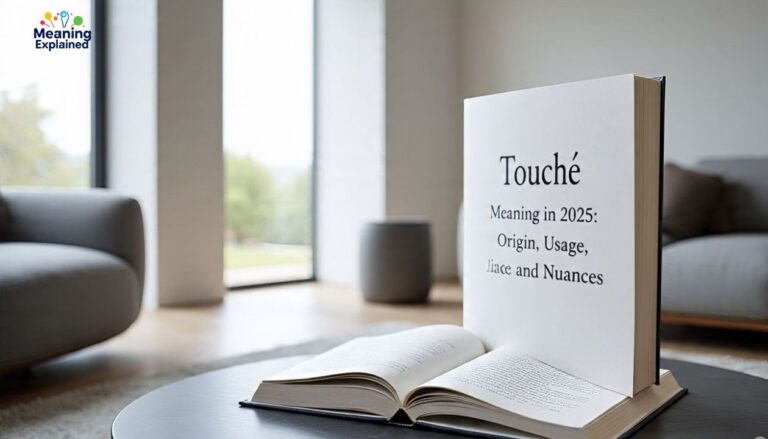The word “touche” pops up in conversations, but its meaning can be tricky to pin down. It’s a term that adds flair to discussions, often used to acknowledge a clever point. This article explores where “touche” comes from, how it’s used today, and its subtle tones in 2025.
From its roots in French fencing to its place in modern English, “touche” carries a unique charm. It’s a way to say, “You got me!” without losing face. We’ll look at its everyday use, especially in playful debates or online chats, and why it’s still popular.
Understanding “touche” helps you sound sharp and witty. Whether in casual talks or social media like X, it’s a quick way to show respect for a smart comeback. Let’s dive into its origin, usage, and nuances to see why it matters in 2025.
What Does “Touche” Mean?
Origin and Basic Definition
“Touche” (pronounced too-SHAY) comes from French, meaning “touched.” Rooted in fencing, it acknowledges a valid hit by an opponent. In English, it’s a conversational term to recognize a clever point or witty comeback in discussions.
Common Usage in English
In 2025, “touche” is used to say, “Well played!” or “You got me!” It’s common in friendly debates, online exchanges, or playful arguments, especially on platforms like X. It signals respect for a sharp remark without escalating tension.
Example:
- Person A: “You missed our meeting yesterday.”
- Person B: “Touche! I owe you one.”
Nuances of Tone
The tone of “touche” varies:
- Playful: Used in lighthearted banter.
- Slightly Sarcastic: Hints at mock defeat.
- Respectful: Shows admiration for wit.
It remains non-confrontational, fitting casual and semi-formal settings.
What Does “Hiatus” Mean?
Definition and Usage
“Hiatus,” from Latin meaning “gap,” refers to a pause or break in continuity. It describes temporary stops in activities like projects, shows, or careers. In 2025, it’s widely used in media and professional contexts.
When to Use “Hiatus”
Use “hiatus” for formal descriptions of interruptions, such as a TV show pausing between seasons or a company halting operations briefly. It’s less common in casual speech.
Examples:
- “The series is on hiatus until 2026.”
- “She took a hiatus from work to travel.”
Tone and Context
“Hiatus” carries a neutral-to-formal tone, ideal for professional, academic, or media settings. It conveys a planned or temporary pause, avoiding casual overuse.
Stand For And Meaning in Text

Stand For
“Stand for” means to represent or symbolize something.
Example: “NASA stands for National Aeronautics and Space Administration.”
And
“And” connects words, phrases, or clauses.
Example: “I bought pens and notebooks.”
Alternatives to these terms can refine communication based on context.
Polite, Professional, and Casual Alternatives to “Stand For”
Choosing alternatives depends on audience and formality.
1. Polite Alternatives
- Represent: “The symbol represents unity.”
- Symbolize: “The rose symbolizes love.”
- Denote: “This term denotes quality.”
2. Professional Alternatives
- Signify: “The change signifies progress.”
- Embody: “The brand embodies trust.”
- Stands as an abbreviation for: “AI stands as an abbreviation for Artificial Intelligence.”
3. Casual Alternatives
- Means: “LOL means Laughing Out Loud.”
- Is short for: “BRB is short for Be Right Back.”
- Means to say: “FYI means to say For Your Information.”
Polite, Professional, and Casual Alternatives to “And”
Alternatives to “and” add style or clarity, especially in formal or creative writing.
1. Polite Alternatives
- Along with: “We’ll bring tea along with biscuits.”
- As well as: “She’s skilled in writing as well as editing.”
2. Professional Alternatives
- In addition to: “In addition to the proposal, include a budget.”
- Together with: “The director, together with the team, finalized the plan.”
- Plus: “The package includes tools plus training.”
3. Casual Alternatives
- Also: “I got pizza and also soda.”
- Plus: “We went hiking plus camping.”
- Alongside: “He works alongside his cousin.”
Choosing the Right Alternative: Tone and Context Matter
- Formal/Professional: Use “signify,” “in addition to,” or “embody” for clarity and professionalism.
- Casual Settings: Opt for “means,” “also,” or “plus” for a friendly tone.
- Polite Situations: Choose “along with” or “represents” for courtesy without stiffness.
Examples of Using These Alternatives in Sentences

- Original: “NASA stands for National Aeronautics and Space Administration.” Alternative: “NASA represents the National Aeronautics and Space Administration.” Explanation: “Represents” is a polite alternative, ideal for formal or educational contexts like reports or presentations, conveying clarity and respect.
- Original: “The dove stands for peace.” Alternative: “The dove symbolizes peace.” Explanation: “Symbolizes” is polite and works well in formal writing or speeches, emphasizing a deeper, symbolic meaning.
- Original: “This sign stands for no parking.” Alternative: “This sign denotes no parking.” Explanation: “Denotes” is polite and precise, suitable for formal instructions or signage explanations in professional settings.
- Original: “LOL stands for Laughing Out Loud.” Alternative: “LOL means Laughing Out Loud.” Explanation: “Means” is a casual alternative, perfect for informal texts or chats, especially on platforms like X in 2025.
- Original: “IDK stands for I Don’t Know.” Alternative: “IDK is short for I Don’t Know.” Explanation: “Is short for” is casual, commonly used in relaxed conversations or social media to explain abbreviations.
- Original: “IMO stands for In My Opinion.” Alternative: “IMO means to say In My Opinion.” Explanation: “Means to say” is casual, fitting for informal contexts like online forums or group chats to clarify acronyms.
- Original: “The logo stands for our brand’s values.” Alternative: “The logo embodies our brand’s values.” Explanation: “Embodies” is professional, ideal for corporate communications or marketing materials, suggesting a strong representation.
- Original: “This term stands for a new policy.” Alternative: “This term signifies a new policy.” Explanation: “Signifies” is professional, used in formal documents or meetings to indicate importance or change.
- Original: “FAQ stands for Frequently Asked Questions.” Alternative: “FAQ stands as an abbreviation for Frequently Asked Questions.” Explanation: “Stands as an abbreviation for” is professional, suitable for technical writing or official guides.
- Original: “We bought apples and oranges.” Alternative: “We bought apples along with oranges.” Explanation: “Along with” is polite, fitting for courteous conversations or written invitations, maintaining a friendly tone.
- Original: “She’s good at math and science.” Alternative: “She’s good at math as well as science.” Explanation: “As well as” is polite, used in formal or semi-formal contexts like academic discussions to connect ideas smoothly.
- Original: “The report and analysis are due tomorrow.” Alternative: “In addition to the report, the analysis is due tomorrow.” Explanation: “In addition to” is professional, ideal for workplace emails or instructions, emphasizing clarity and formality.
- Original: “The team and manager finalized the plan.” Alternative: “The team, together with the manager, finalized the plan.” Explanation: “Together with” is professional, suitable for formal reports or collaborative contexts, highlighting joint effort.
- Original: “The package includes training and support.” Alternative: “The package includes training plus support.” Explanation: “Plus” is professional yet concise, used in business proposals or service descriptions for clarity.
- Original: “I got coffee and bagels.” Alternative: “I got coffee and also bagels.” Explanation: “Also” is casual, perfect for everyday conversations or texts, keeping the tone light and informal.
- Original: “We visited the park and the museum.” Alternative: “We visited the park plus the museum.” Explanation: “Plus” is casual, commonly used in informal settings like storytelling or casual plans with friends.
- Original: “He works with his brother and sister.” Alternative: “He works alongside his brother and sister.” Explanation: “Alongside” is casual, fitting for describing teamwork in relaxed or creative environments.
- Original: “ASAP stands for As Soon As Possible.” Alternative: “ASAP denotes As Soon As Possible.” Explanation: “Denotes” is polite, used in semi-formal contexts like workplace emails to explain terms clearly.
- Original: “The policy and guidelines were updated.” Alternative: “The policy, in addition to the guidelines, was updated.” Explanation: “In addition to” is professional, ideal for formal announcements or policy documents to ensure clarity.
- Original: “The symbol stands for equality.” Alternative: “The symbol signifies equality.” Explanation: “Signifies” is professional, suitable for academic or advocacy contexts, emphasizing the importance of the symbol.
Final Words
“Touche” remains a vibrant word in 2025, adding wit and charm to conversations, especially in playful debates or online exchanges on platforms like X. Its French fencing origin enriches its use as a respectful nod to a clever point. Alternatives to “stand for” and “and” offer flexibility, letting you tailor your language to any setting. Whether formal or casual, choosing the right word enhances clarity and connection. Keep tone and audience in mind to make your communication shine.
“Hiatus” also holds its place, describing pauses in a formal yet accessible way, perfect for media or professional contexts. Using varied vocabulary like “signify” or “plus” keeps your language fresh and engaging. In 2025, mastering these terms helps you navigate discussions with ease. Practice them in daily chats or posts to sound sharp and relevant. Language is a tool—use it wisely to leave a lasting impression.

